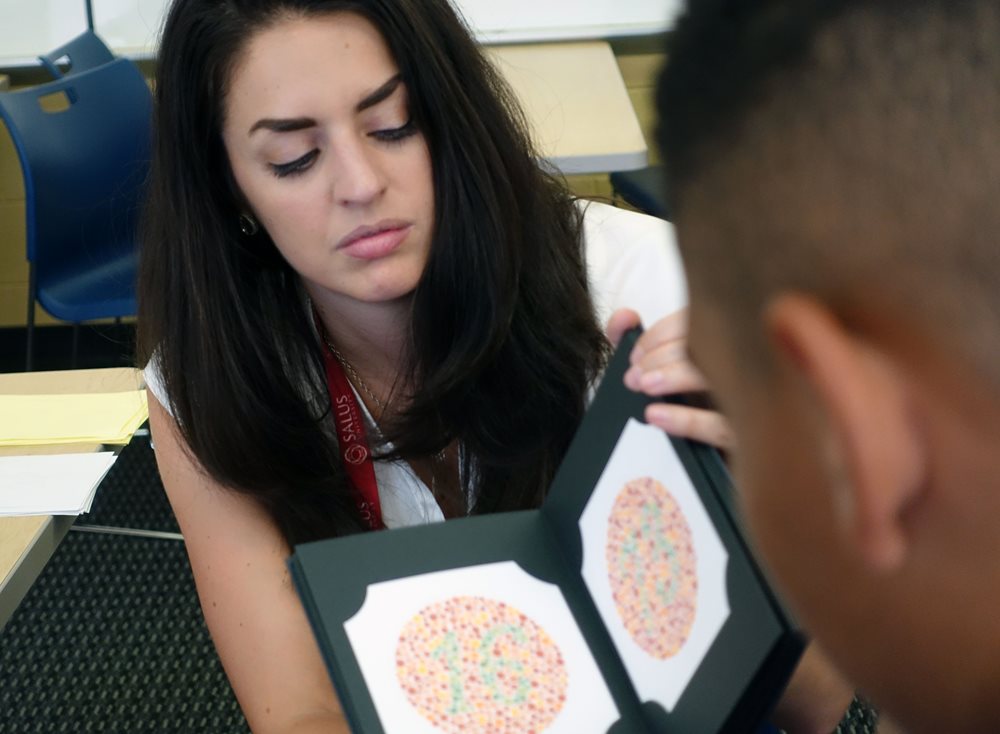The Colorful Truth: How We See (Or Don’t See) Color
Most people with color vision deficiency can see colors and are not truly color blind. The most common types are inherited red-green color deficiencies which occur in approximately one in 12 genetic males and one in 200 genetic females, according to Dr. Elise Ciner.
Depending on the severity, people with red-green inherited color deficiencies have varying difficulties differentiating between red, orange, yellow and green especially with pastel or muddy colors or in poor lighting.
 Dr. Elise Ciner, co-director, Special Populations Assessment and Rehabilitation Center at The Eye Institute, Pennsylvania College of Optometry (PCO), Salus University, said true color blindness, in which everything is seen in shades of grey, is called achromatopsia which is extremely rare and accompanied by significantly reduced visual acuity and extreme light sensitivity.
Dr. Elise Ciner, co-director, Special Populations Assessment and Rehabilitation Center at The Eye Institute, Pennsylvania College of Optometry (PCO), Salus University, said true color blindness, in which everything is seen in shades of grey, is called achromatopsia which is extremely rare and accompanied by significantly reduced visual acuity and extreme light sensitivity.
“The ability to see colors is a very complex process beginning in the retina,” said Dr. Cinar.
The retina has two categories of photoreceptors each with its own light-sensitive pigments. The first, called rods, are used primarily at night or in dark environments and do not help us see colors. The second, called cones, are of three types:
- First: most sensitive to long wavelengths (red light)
- Second: most sensitive to medium wavelengths (green light)
- Third: most sensitive to short wavelengths (blue light).
These three cone types can respond to lights of different wavelengths or colors, turning these photons of light into electrical energy in our retinas, but their response is higher at or near their preferred wavelength. After cones respond to light, the information is further processed by other cells in the retina, after which it travels along the optic nerve to the visual cortex or “seeing” part of our brains where it is processed even further.
An inherited color deficiency occurs if either one type of cone is missing (for example, the red or green sensitive cones) or if the peak sensitivity of one of the cones has shifted so that it is similar to another type of cone (for example, the long wavelength sensitive cone’s peak sensitivity has shifted away from red light and closer to green light). The result in either case would be a person who is less sensitive to either red or green.
“Red-green color deficiencies are X-linked meaning they are passed along the X chromosome,” said Dr. Ciner. “To have an inherited color deficiency, a genetic male (XY) would therefore only need one affected gene, while a genetic female (XX) would need two affected genes. A genetic female with only one affected gene would be a ‘carrier’ and would have normal color vision but could pass the affected X gene to the next generation.”
 Many jobs/professions benefit from good color vision. For example, electricians, airline pilots, law enforcement, some military personnel, food or meat inspectors, graphic designers, jewelry appraisers and certain medical professionals each require good color vision skills. Each profession establishes its own criteria including which tests are acceptable to administer to evaluate the presence and severity of a person’s color deficiency.
Many jobs/professions benefit from good color vision. For example, electricians, airline pilots, law enforcement, some military personnel, food or meat inspectors, graphic designers, jewelry appraisers and certain medical professionals each require good color vision skills. Each profession establishes its own criteria including which tests are acceptable to administer to evaluate the presence and severity of a person’s color deficiency.
Difficulties with color can be either inherited or acquired. Inherited color vision problems do not change throughout life and some people do not even realize they have a color vision deficiency. Acquired color vision deficiencies can occur at any age and they are sometimes more noticeable or different between the eyes. They can also be either red-green; blue-yellow or have no specific pattern to them. They can be associated with one or more of the following:
- Age Related changes
- Eye diseases and injuries
- Traumatic brain injury
- Certain medications
- Chemical toxicity
There are different types of tests used to diagnose color vision deficiencies. These include:
- Tests that contain many multi-colored dots (pseudo-isochromatic plate tests) that form a shape or number in the center that is visible to persons with normal color vision but confusing or not visible to those with color deficiencies.
- Another type of test requires the person to put ‘caps’ in color order.
- A third type which can definitively evaluate both the type and severity of the color vision deficiency asks the patient to look into an instrument and match lights of different colors.
- Newer tests have also recently been developed and are used by several agencies (for example the Federal Aviation Administration now only allows certain computer-based color vision tests for pilots).
“There is currently no cure for congenital color deficiencies. There are, however, various types of special glasses or contact lenses which can help someone differentiate colors that may or may not be allowed for their job or profession,” said Dr. Ciner. “There are also filters that can be placed over tablets or computer screens that may help differentiate colors better for some individuals engaged in learning or work-related color-based graphics. Neither of these provides a cure but may be beneficial in certain circumstances.
A true cure for inherited color vision deficiencies will require genetic research which has only just begun in non-humans.
“Our ability to see and process colors is a very amazing and complicated process involving multiple levels of processing beginning with the eyes but continuing through to the seeing parts of brain,” Dr. Ciner said.
If you want to learn more about your color vision or know someone who may be having challenges with certain colors and is interested in further testing, contact The Eye Institute at 215.276.6111.